
Sukajan Goes Global: Yokosuka’s Souvenir Jacket, Base-Town Craft, and the Embroidered Story That Traveled the World
Sukajan isn’t just “cool Japanese embroidery on satin.” It’s a wearable artifact of postwar history — a garment born from the collision of American military base culture and Japanese craft tradition, then reinterpreted by subcultures, luxury fashion, and global collectors. While it’s often treated today as a streetwear statement, the sukajan’s deeper power comes from what it contains: memory, place, technique, and a very specific origin story.
At its core, a sukajan (from “Yokosuka jumper”) is a jacket made from glossy fabrics like satin, rayon, or velveteen, carrying bold “Oriental” motifs — eagles, hawks, dragons, tigers — stitched in dramatic threadwork. What makes that combination historically meaningful is that it formed during the years after WWII, when Japan entered the Occupation era and U.S. bases became dense cultural contact zones. In this moment, souvenirs weren’t trivial — they were the physical proof of “I was there,” and jackets became one of the most visible forms of that proof. Scholars of fashion history often describe sukajan as souvenirs for American troops in Occupied Japan (1945–1952), later spreading across bases worldwide as commemorative items.
Born in Yokosuka as a Souvenir for American Soldiers
"Sukajan'' is a jacket made of satin or beige fabric with oriental embroidery such as eagles, hawks, tigers, and dragons. Although it is a fashion that originated in Japan, it is now loved by many overseas celebrities. Sukajan is becoming increasingly popular around the world, with high-end brands such as Louis Vuitton and Gucci incorporating it at the 2016 Paris Fashion Week.
Sukajan was born on Dobuita Street in Honmachi, Yokosuka City, Kanagawa Prefecture. The name comes from "Yokosuka Jumper". In 2018, Dobuita Dori Shopping Street was declared the ``birthplace of Sukajan'' in order to promote local traditional crafts.
For the 2021 Tokyo Olympics, we also produced Skajan jackets, which are official goods. When athletes who purchased the jacket at the Olympic Village posted pictures of themselves wearing it on social media, it received a huge response from all over the world, with comments such as ``Cool jacket'' and ``Gorgeous!''. ``We received a flood of inquiries, and the PR effect was better than we expected,'' said Kazuyoshi Hitomoto, vice president of the Dobuita Street Shopping District Promotion Association.
Sukajan’s origin story matters because it explains why the jacket still feels “different” today: it was designed to be carried across borders from the beginning. Dobuita’s “birthplace” messaging is not just tourism — it’s a way to keep the jacket’s geography legible in an era where anyone can buy a sukajan online.
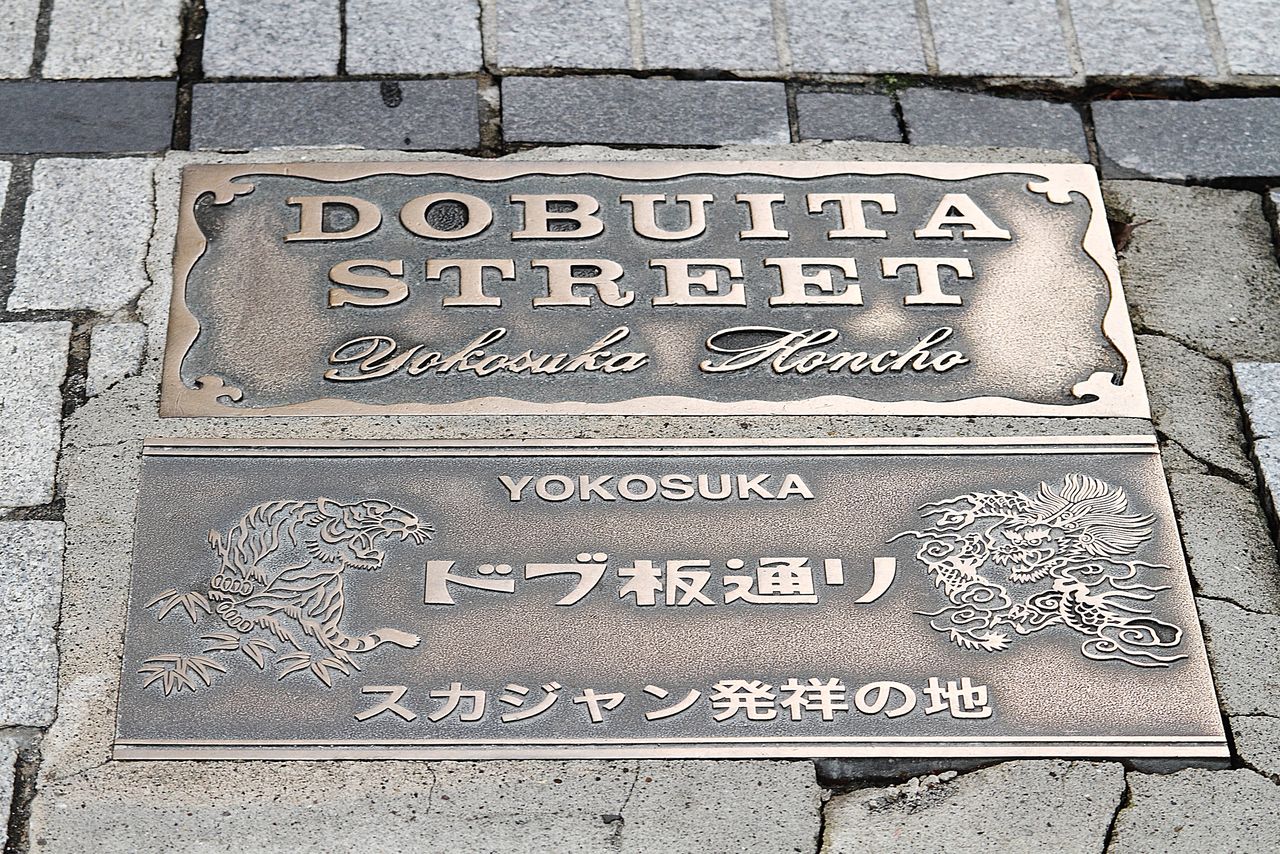
A plate that says “Birthplace of Sukajan” embedded in the road of Dobuita-dori shopping street
***The Dobuita-dori shopping street is lined with restaurants and souvenir shops with signs in English as can be seen in the photo on top.
After World War II, the U.S. Navy was stationed in Yokosuka, having requisitioned Japanese Navy facilities. It became known as the "base town."
Running parallel to National Route 16, where the front gate of the U.S. Navy Yokosuka Base is located, is Dobuita Dori, a 300-meter-long street. Shortly after the war, restaurants, tailors, and souvenir shops catering to American soldiers were lined up in the area, and it became very lively.
Seen in curator terms, this “base town” economy is the engine that made sukajan possible: soldiers brought spending power and a customization habit; makers brought speed, craft knowledge, and an instinct for what foreign customers wanted to carry home as proof of their time in Japan.
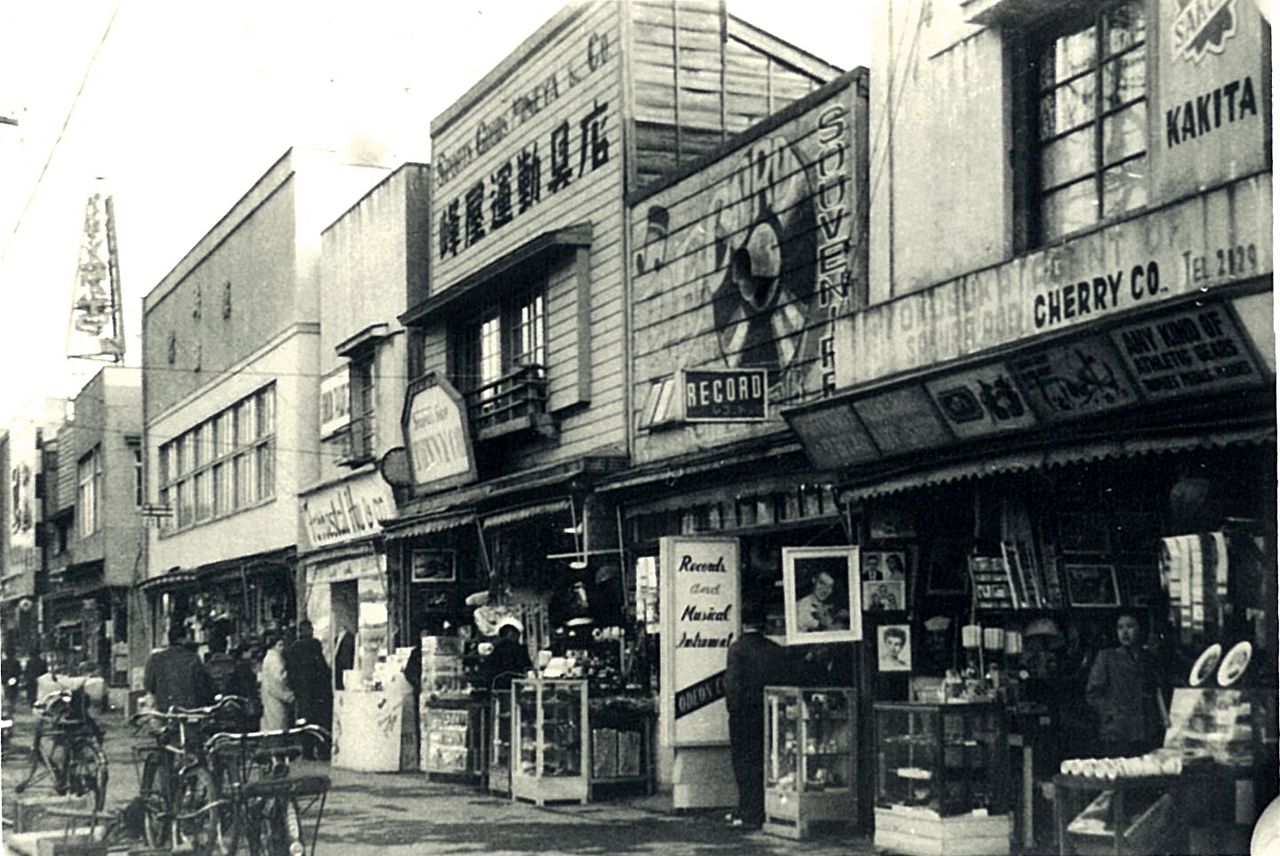
Dobuita Street in the 1940s Image provided by: Yokosuka City Central Library
``The roots of the Skajan jacket are the jackets that American soldiers used as souvenirs (souvenirs) from their stay in Japan,'' Ippon says. While serving as the manager of MIKASA, a shop specializing in Sukajan jackets founded in 1950, he also founded the Dobuita Sukajan Research Group with Hiromichi Yokochi, a Sukajan artist.
The two explore the history of the city and collect embroidered products that were sold as souvenirs around the world after World War II. Some of them are on display at Dobuita Station, a general information center in the shopping district.
Their work matters because sukajan is often misunderstood as “random embroidered jackets.” In reality, collectors can read era, intent, and origin through details: motif placement, text like “JAPAN / YOKOSUKA,” material sheen, and embroidery density.
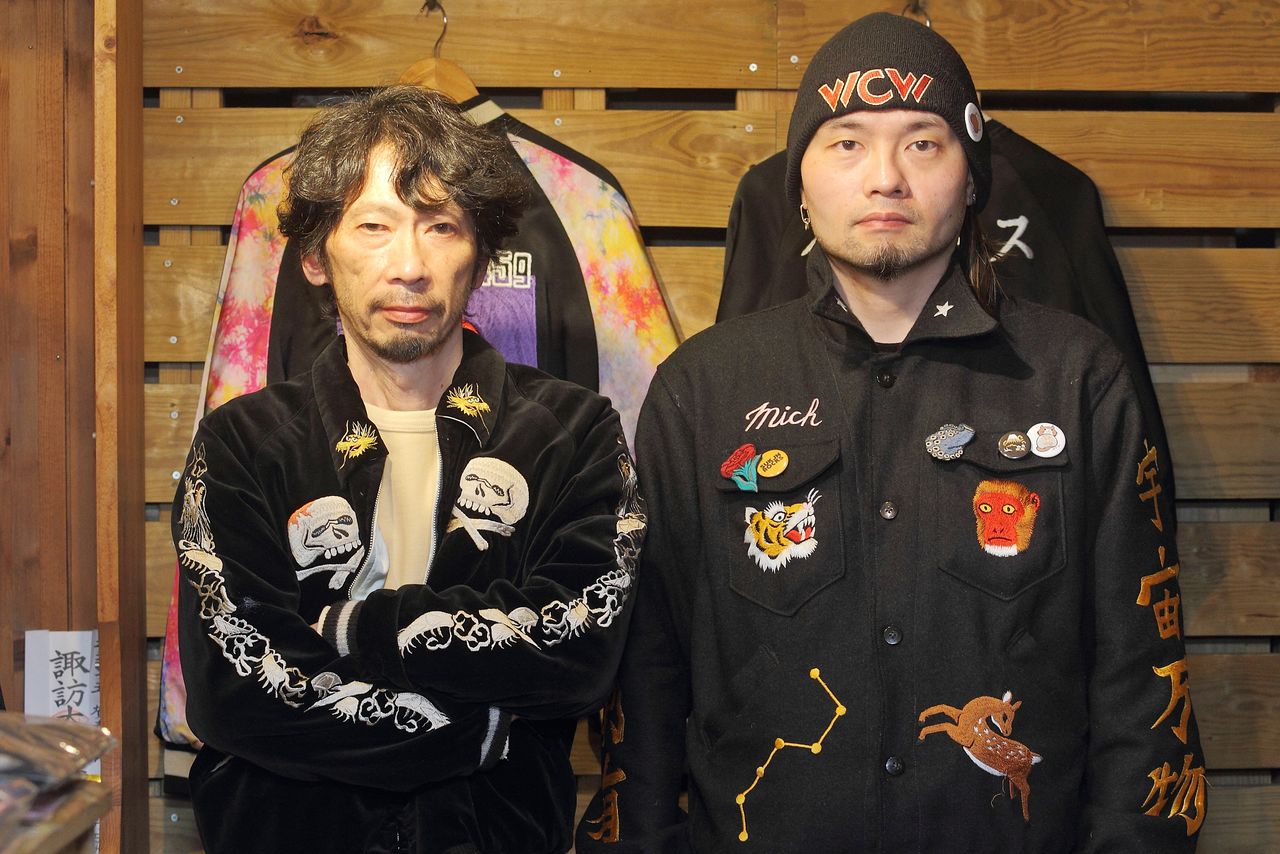
Mr. Ippon (left) and Mr. Yokochi both served as vice presidents of the Dobuitadori Shopping District Promotion Association, and were also involved in the production of the Tokyo Olympics sukajan.
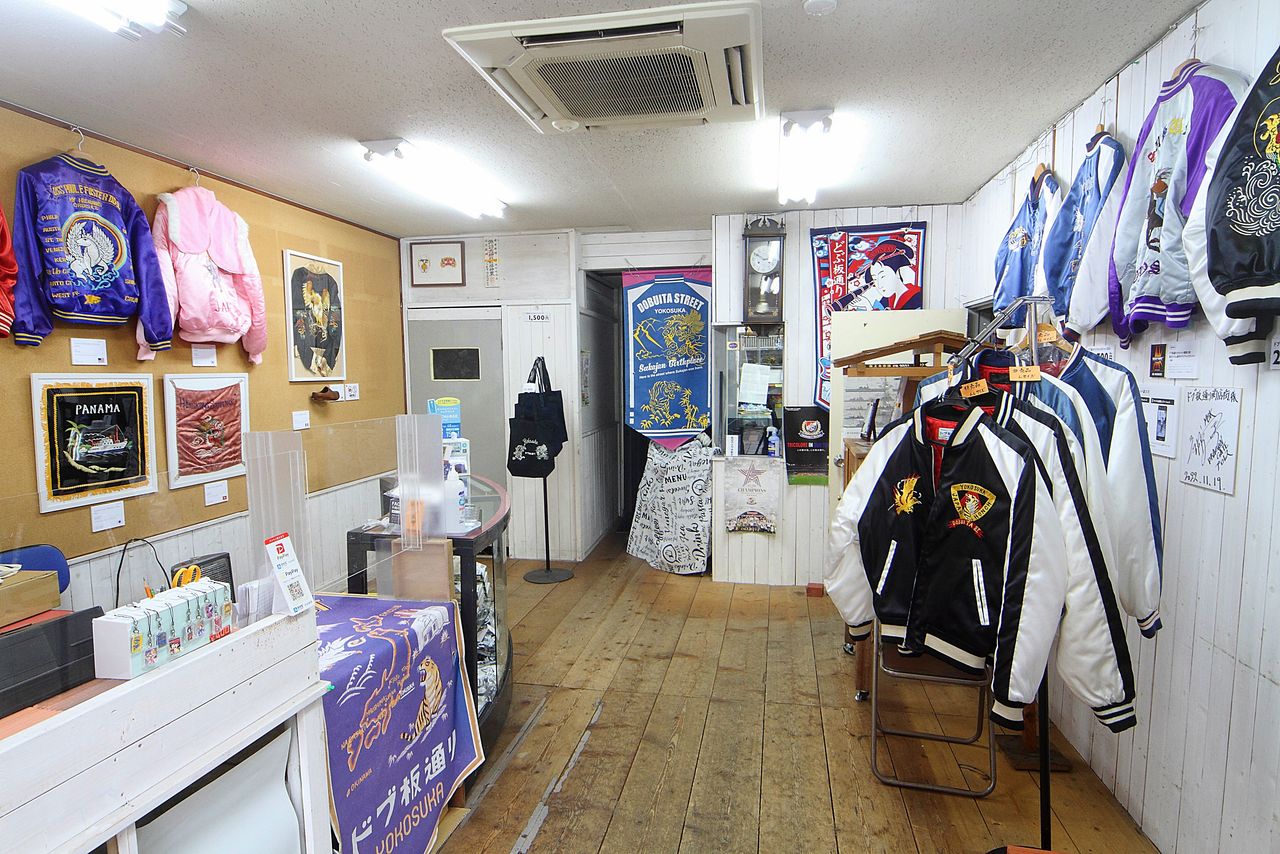
"Dobuita Station" is adjacent to MIKASA. In addition to selling shopping street original sukajans and other items, some of the duo's collections are on display.
Sewing oriental motifs using traditional embroidery techniques
Mr. Ippon explains that the "custom culture of American soldiers'' is behind the creation of Sukajan.
A good example is putting lots of patches on flight jackets and stadium jumpers. As an extension of that, we took the clothes to a tailor and had traditional Japanese embroidery done on them. Gradually, ready-made jumpers were decorated with patterns favored by American soldiers. appeared and began to be sold at souvenir shops.
That customization habit is key: sukajan didn’t start as a “brand product,” but as a response to requests. American silhouettes (stadium/baseball jacket logic) met Japanese craft execution — and the result became its own category.
Tigers and dragons, which give off an oriental feel, are standard, but at first, the country's national flag, the Star-Spangled Banner, and the national bird, the bald eagle, were also popular. Yokochi's collection includes a jacket made in 1949 with a unique design that features the stars and stripes on the wings of an eagle.
Probably, the maker used his ingenuity to respond to an order as simple as "I want Mt. Fuji and an eagle embroidered.'' Embroidered souvenir jackets were made in many countries, but the ones made in Japan The design was particularly high.'' (Yokochi)
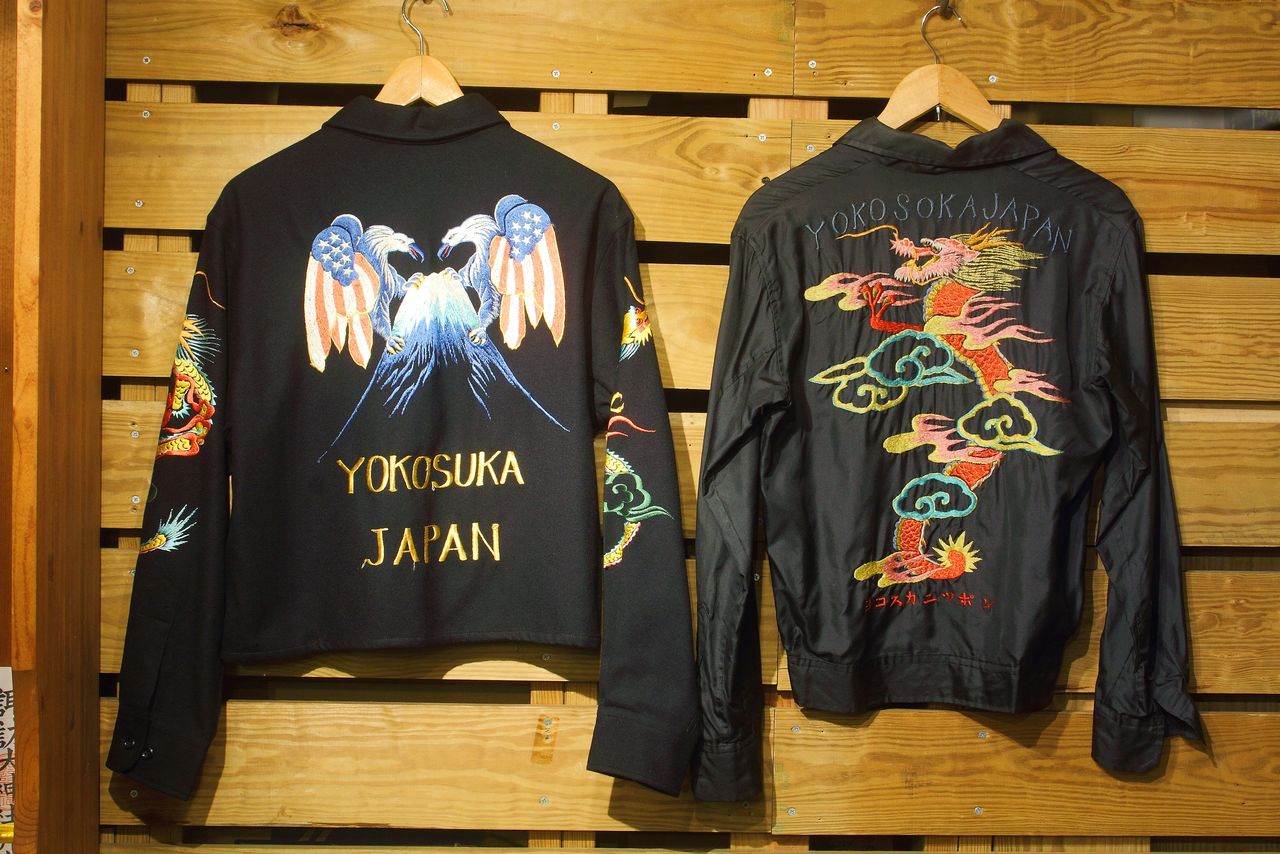
The roots of the sukajan were jackets with custom embroidery like the one pictured above.
Early sukajans used horizontal embroidery to decorate the kimono and obi. This is a technique in which the craftsman uses a ``horizontal sewing machine,'' where the needle moves from side to side, to move the fabric by hand while adjusting the stitch width and speed using a lever on his knee or a pedal at his foot. The delicate, three-dimensional embroidery, also known as ``thread paintings,'' fascinated American soldiers.
Curator clarification: this “thread painting” effect is the visual signature that separates heritage-grade sukajan from flat, mass-produced imitation. It’s depth, shading, and controlled density — an image built out of stitch logic, not ink.
"Mr. Matsuzaka of First Shokai (custom-made sukajan store) is still working on a horizontal embroidery machine even though he is over 90 years old," says Ippon, so you can do horizontal embroidery even on the street. There was a craftsman. However, the home of embroidery was Kiryu in Gunma Prefecture.
Kiryu has flourished in textiles and textiles since ancient times, and horizontal embroidery has been passed down as a traditional craft, and there were many skilled craftsmen with advanced techniques. Since the 1950s, it has become a major producer of Skajan jackets, and even today, when commercial embroidery machines have developed, many small-batch high-end products are made in Kiryu.

Delicate dragon embroidery on the front chest pocket of the "Eagle and the Stars and Stripes'' jacket.
In addition to the design and embroidery technique, the shiny and smooth feel of the satin fabric is also what made it popular with foreigners.
Skajans gradually became mainstream as stadium jackets that were easy to wear on a daily basis, but while stadium jackets were made of thicker materials such as wool and leather, sukajans were made of thinner satin fabrics made of rayon or acetate. This is a plant-based fiber unique to Japan that resembles silk, and was once called "artificial silk.''
That sheen isn’t just decoration — it amplifies embroidery at distance and under light. It’s part of why sukajan reads as “luxury-casual”: a practical jacket that still carries a high-finish surface.
Yokochi speculates, "Silk products, which were known as high-quality Oriental fabrics, were especially favored by American soldiers as gifts for women. Skajans made of satin fabric similar to silk probably caught their attention.'' do.
However, there is a theory that "the earliest Skajans were made from parachutes (lightweight silk) discarded by the U.S. military after the war,'' but this is probably just an old sales pitch. Due to the post-war period of turmoil, truth and fiction may have been mixed together.
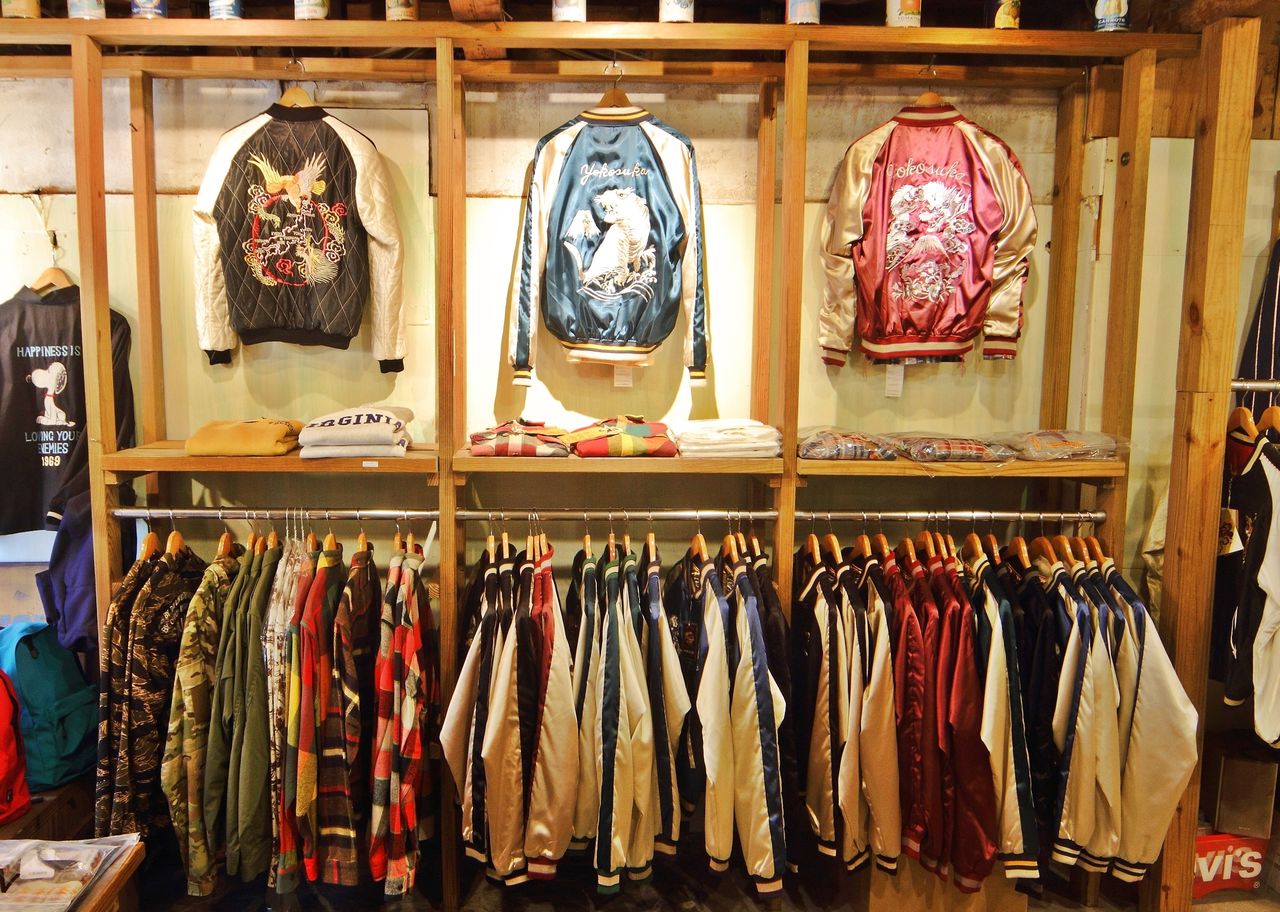
Satin fabrics with a stadium jacket silhouette are the current mainstream, and luxurious becchin fabrics are also popular.
From souvenirs to fashion, fans spread all over the world
Eventually, in the 1960s, a period of high economic growth, the sukajan changed from a souvenir to a fashion item. As a kind of re-importation of the trend, young Japanese people who admire American casual style began to wear it.
This is the moment where sukajan becomes a true fashion language: it stops being only “proof of travel” and starts becoming “proof of taste.” Over time, the meaning continues to shift — rebellion, music culture, collector heritage, and eventually runway reinterpretation.
Initially, it was worn by delinquents, as in the 1961 movie "Pigs and Gunkans" (directed by Shohei Imamura, starring Hiroyuki Nagato), which was set in the street Dobuita, where the main character, a thug, wore a sukajan. Gradually, it spread among fans as they imitated rock musicians who loved wearing Skajan jackets. Around this time, MIKASA, which had been a souvenir shop for U.S. soldiers, "gradually turned into a fashion store catering mainly to Japanese customers,'' Ippon says.
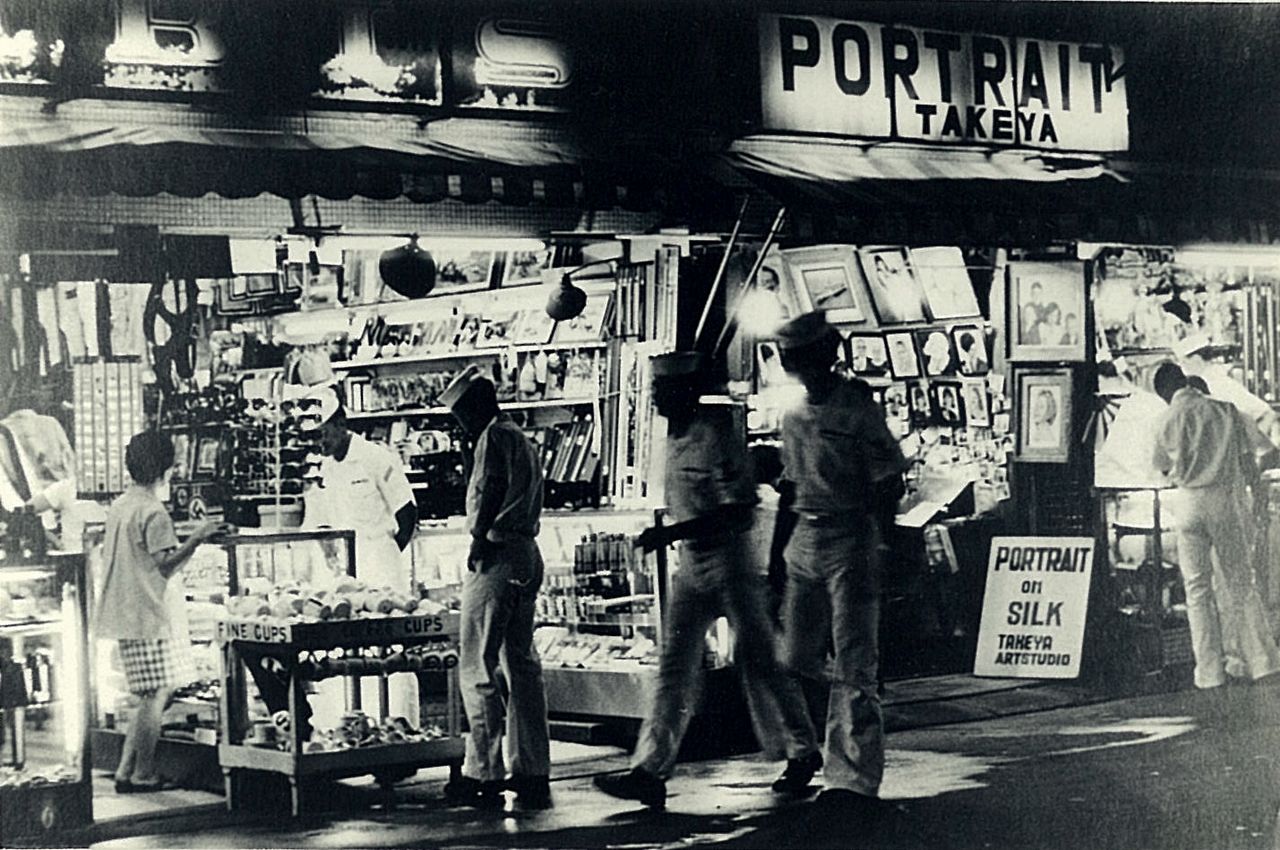
Dobuita street around 1970. The atmosphere of the shopping district, where you can feel American culture, also attracted young Japanese people. Image provided by: Yokosuka City Central Library
Currently, MIKASA has a wide range of customers, from young people in their 20s to the elderly, and before the coronavirus outbreak, there were many inbound customers. Yokochi says, "Until a long time ago, sukajan jackets were synonymous with delinquent culture.Nowadays, you can see them dressed up in foreign movies, and the cute patterns and reasonable prices are also popular among young women.''
The global shift is also structural: once high fashion recognized sukajan as a complete system (silhouette + shine + motif + story), it became infinitely “translatable.” That’s why you now see sukajan logic across luxury, streetwear, and collector culture.
However, both of them are concerned about the current situation, saying, "Yokosuka's specialty stores haven't really picked up on the needs of these current trends.'' Paris Fashion Week served as an impetus for apparel manufacturers from all over the world to start making them. In the first place, skajans used to have place names such as "JAPAN'' and "YOKOSUKA'' printed on them to commemorate their stay, but in this day and age, when people can buy them online, the image that "skajans = Yokosuka'' has faded.
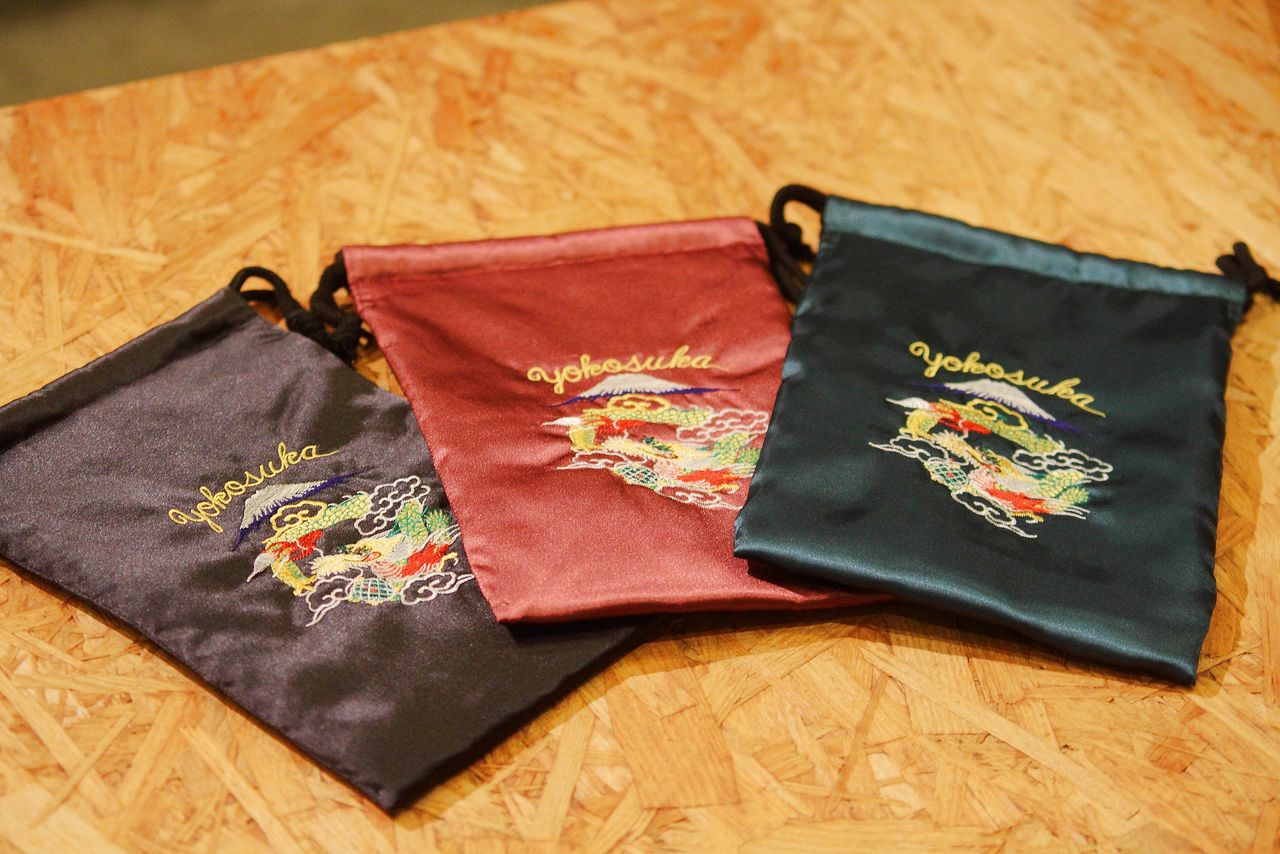
MIKASA's popular product is the Sukajan-patterned kinchaku bag, which you can easily buy as a souvenir of your stay in Yokosuka.
That's why the Dobuita-dori shopping street has teamed up with the city to promote itself as the "birthplace.'' Thanks to these efforts, there are many Skajan fans who love the authentic handmade feel and say they only buy their clothes in Yokosuka.
Curator note: as e-commerce flattens geography, origin storytelling becomes the new “authentication layer.” The goal isn’t to gatekeep sukajan — it’s to keep its birthplace readable even as the jacket spreads worldwide.
Looking further into the future, the two devised "NFT Skajan," which has value in virtual spaces such as the Metaverse. This is an attempt to wear the real thing in real life, and then make the avatar wear a CG version of the same design in virtual space. NFT (Non-Fungible Token) is a technology that proves the authenticity of digital data that is easy to forge or copy, and is also used in art and fashion. He thought that it would be possible to design a one-of-a-kind pattern, and that it would match well with sukajan, which is also a craft.
This idea is a modern extension of an old impulse: identity through ownership. Where the postwar sukajan proved “I was there,” the digital counterpart attempts to prove “this design is mine” in a world where images replicate endlessly.
Will the Sukajan trend, which spread all over the world from a souvenir shop on Yokosuka Dobuita Street, spread to virtual spaces? I would like to pay attention to future trends.
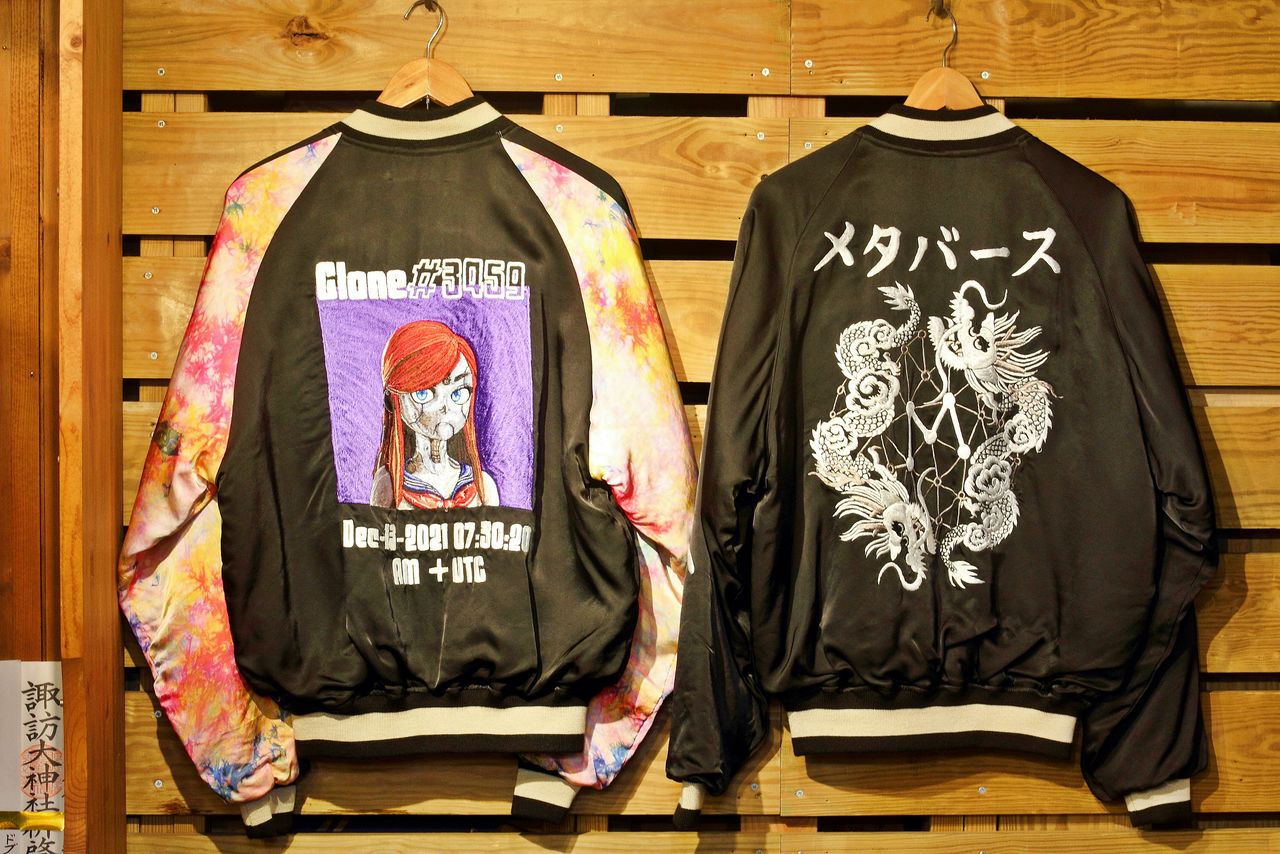
"NFT Sukajan" can be worn in conjunction with the real world and virtual space. Katakana is said to be a popular design in virtual space.
Closing curator note: Sukajan didn’t “become” global — it was global from birth. Made for foreigners, carried across oceans, adopted by Japanese youth as re-imported cool, and now revalidated as craft heritage and runway language. If you want to wear it properly (in spirit), treat it like what it is: a jacket that carries place, technique, and cultural contact stitched into satin.
